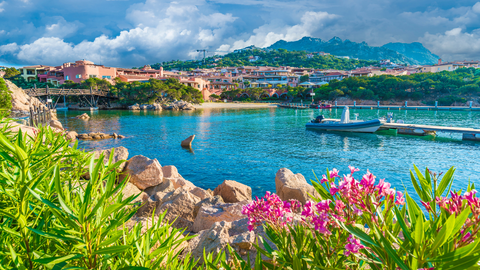Sardinia's rugged beauty and pristine beaches are only half the story. This Mediterranean Island boasts a rich culinary heritage, shaped by its pastoral and agricultural roots. From hearty peasant fare to decadent pastries, Sardinian cuisine is a delicious adventure waiting to be explored. Here is a selection of Sardinian typical dishes not to be missed to fully savor the culinary culture of Sardinia.
Culurgiones

Culurgiones are delightful pockets of flavor. These dumpling-shaped pasta are filled with a savory blend of potatoes, pecorino cheese, and fresh mint. Their unique shape, featuring a pointed edge reminiscent of a wheat ear, is often adorned with decorative details. Traditionally served with a simple tomato sauce and fragrant basil, culurgiones can also be enjoyed with a buttery sage sauce.
Zuppa Gallurese
Don’t be fooled by the name “soup”! Zuppa gallurese is a hearty dish originating from Gallura, a region in northern Sardinia. Layers of seasoned, stale bread are bathed in a rich meat broth and layered with herbs like mint and parsley. The entire dish is baked in the oven, creating a comforting and flavorful casserole, resembling lasagna in texture despite its name suggesting a soup.
Malloreddus

Malloreddus, also known as Sardinian gnocchetti, are small, ribbed shells crafted from durum wheat semolina, water, and salt. Often dyed a vibrant yellow with saffron, especially during All-Saints' Day celebrations, they are typically enjoyed with a robust meat sauce called "sugo di pomodoro." These little dumplings are a staple at Sardinian weddings and engagement celebrations. In a charming tradition, the bride-to-be might even walk through the village carrying a basket overflowing with malloreddus for guests.
Sa Fregula

Sa fregula is a unique and ancient island staple. Made from durum wheat semolina and water, these tiny balls of dough are rolled and dried under the warm Sardinian sun on a special sieve. This versatile ingredient readily absorbs the flavors of accompanying meats, fish, or vegetables, making it a delicious and essential part of Sardinian cuisine. Fregula comes in two main varieties: "fregula sarda" which is toasted for a deeper flavor, and "fregula fresca" which is not toasted.
Porceddu
Porceddu reigns supreme as one of the most iconic dishes of Sardinia. This slow-roasted suckling pig is meticulously prepared using pigs no more than 20 days old and weighing around 4-5 kg. The entire pig is skewered and cooked vertically over an open fire, ensuring even cooking while being frequently basted with fragrant myrtle and rosemary leaves. Patience is key with this dish, as preparation can take anywhere from 3 to 5 hours. The wait is undoubtedly worth it, and porceddu pairs beautifully with local Sardinian red wines.
Pardulas
Hailing from the Sulcis and Campidano regions, pardulas are traditional Easter sweets. These bite-sized treats boast a delightful filling of sheep's ricotta cheese, saffron, and lemon zest, sometimes featuring variations with cheese flavored by orange or lemon zest. The filling is enveloped in a crisp and flaky puff pastry made with durum wheat semolina. Pardulas can be finished with a dusting of powdered sugar or a glistening drizzle of honey. Best enjoyed warm, these little pastries are a true indulgence.
Seadas
Seadas are Sardinia's quintessential dessert. These golden fried pastries are made with a semolina dough and filled with fresh ricotta cheese, just curdled and flavored with lemon zest. There are two main variations: one featuring cooked cheese and another with the cheese left fresh. Once prepared, the seadas are fried until golden brown and then generously drizzled with honey. Interestingly, the name "seada" or "sebada" was originally singular, but with wider consumption, the plural form has become more customary. Seadas have roots in Sardinian pastoral culture, not solely as a sweet treat, but as a single, fortifying dish made with readily available ingredients.
Pecorino Sardo

Pecorino Sardo is the island's signature cheese, unsurprising considering Sardinia boasts over 5,000 years of cheesemaking tradition. Crafted from sheep's milk and using kid stomach enzymes in the curdling process, Pecorino Sardo boasts a rich and sharp flavor. Enjoy it grated over pasta dishes for an extra layer of complexity, or melted in a warm, toasted sandwich.
Pane Carasau

This is a thin, crispy flatbread that forms the foundation of many Sardinian dishes. Often used as a base for "pane frattau," carasau is softened slightly in meat broth or water. It's then layered with tomato sauce, fragrant basil, and grated pecorino cheese. For an extra touch, a poached or fried egg can be added, with the yolk breaking over the bread to add richness and moisture. Pane carasau comes in two varieties: "pane carasau" and "pane guttiau." Pane guttiau, which translates to "dripped," is drizzled with extra virgin olive oil, seasoned with salt, and studded with toasted and chopped rosemary before being baked again until crisp. This variation is ideal for enjoying with cured meats, fresh cheeses, or as an appetizer on its own.
Sardinian cuisine is more than just food; it's a journey through the island's history and culture. Each dish reflects the resourcefulness and traditions of the Sardinian people. From the comforting warmth of fregula soup to the sweet indulgence of a ricotta-filled sebada, Sardinia promises an unforgettable culinary experience.



